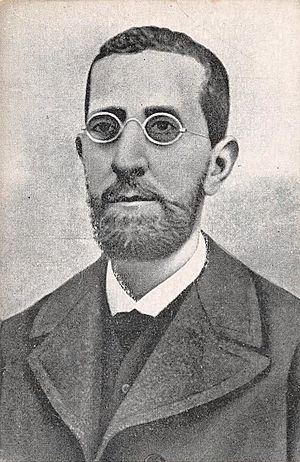Fermín Salvochea facts for kids
Fermín Salvochea y Álvarez (born March 1, 1842, in Cádiz – died September 27, 1907, in Cádiz) was an important Spanish politician. He served as the mayor of Cádiz and also led the province of Cádiz.
He was a key person in spreading anarchist ideas in Spain during the late 1800s. Many people consider him one of the most loved figures in the Spanish Anarchist movement of that time.
Fermín Salvochea's ideas were shaped by thinkers like Bradlaugh, Owen, and Paine. He studied their works while he lived in England. Later, he also read the writings of Kropotkin. In Spain, he connected with other anarchist thinkers and activists.
Contents
Who Was Fermín Salvochea?
Fermín Salvochea was a Spanish politician and a strong supporter of anarchist ideas. He believed in a society where people could live freely without a strict government. He worked to make life better for ordinary people in Spain.
Early Life and Ideas
Fermín was born in Cádiz into a family that was involved in trade. When he was 15, his father sent him to England. The idea was for him to learn about business.
He spent five years in London and Liverpool. However, instead of focusing on trade, Fermín became very interested in social problems. He read books by thinkers who wanted to improve society.
A Life of Activism
Fermín Salvochea became a leader in the Canton of Cádiz during the Cantonal Revolution. This was a time when some areas in Spain tried to govern themselves. He was later captured and sent to prison for several years.
After refusing a pardon, he managed to escape to Morocco. During his time in prison and in exile, he became a firm believer in anarchist communism. This is a type of anarchism that supports a society without private property or a state.
When King Alfonso XII died, Fermín was granted another chance to return home. He came back to Cádiz and started a newspaper called El Socialismo. Through this newspaper, he shared the anarchist communist ideas of Kropotkin with people in Spain.
Fermín Salvochea often gave away his family's wealth and possessions to those who needed help. He chose to live a simple life, without much money or luxury.
His last work was translating a book by Kropotkin called Fields, Factories and Workshops. He passed away on September 28, 1907. His funeral was a very large event, with thousands of workers attending to show their respect.
His Impact and Legacy
Historians see Fermín Salvochea as a key figure in the early anarchist movement. He lived through a time when these ideas were growing in Spain.
An anarchist historian named Manuel Buenacasa Tomeo called Salvochea "our greatest saint." This shows how much people admired him. He was seen as a very good and honest person, which made him a respected figure in the anarchist movement.
See also
 In Spanish: Fermín Salvochea para niños
In Spanish: Fermín Salvochea para niños
- Anarchism in Spain
- List of mayors of Cádiz
Images for kids




